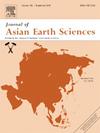Mechanism of crustal deformation around the Lajishan-Jishishan Tectonic Belt, NE Tibet, and implications for occurrence of the 2023 Jishishan MS 6.2 earthquake
IF 2.7
3区 地球科学
Q2 GEOSCIENCES, MULTIDISCIPLINARY
引用次数: 0
Abstract
The Lajishan-Jishishan Tectonic Belt (LJTB) experienced several strong earthquakes in recent decades despite its low slip rate and low strain rate. The latest 2023 Jishishan MS 6.2 earthquake received special attention for its unusual secondary disasters, which raises the question about the mechanism of frequent strong earthquakes in the tectonic belt. In this study, we construct a three-dimensional (3D) viscoelastic finite element model to analyze the crustal deformation and stress–strain state around the LJTB, considering the effects of fault geometry and lateral rheological heterogeneity. The results show that with the uniform rheology in the mid-lower crust, there is a significant strike-slip component at both end segments and a thrust component in the middle segments of the tectonic belt, and strike-slip and weak thrust deformation in the north segments of the belt, indicating the important role of fault geometry in controlling the regional crustal deformation. The strengthening of rheology in the mid-lower crust benefits the fault slip but subtly influences crustal deformation. For the middle and south segments of the LJTB, the crust experiences intense horizontal compression, and the heterogeneous rheology in the mid-lower crust facilitates fault thrust motion, as indicated by the 2023 Jishishan MS 6.2 earthquake. The crustal deformation around the tectonic belt is attributed to the hybrid crustal shortening and localized mid-lower crustal flow. Under the compressive tectonic stress field, the strain energy gradually increases on the Jishishan fault zone located above the mid-lower crust with high rheology, eventually generating the Jishishan MS 6.2 earthquake.
求助全文
约1分钟内获得全文
求助全文
来源期刊

Journal of Asian Earth Sciences
地学-地球科学综合
CiteScore
5.90
自引率
10.00%
发文量
324
审稿时长
71 days
期刊介绍:
Journal of Asian Earth Sciences has an open access mirror journal Journal of Asian Earth Sciences: X, sharing the same aims and scope, editorial team, submission system and rigorous peer review.
The Journal of Asian Earth Sciences is an international interdisciplinary journal devoted to all aspects of research related to the solid Earth Sciences of Asia. The Journal publishes high quality, peer-reviewed scientific papers on the regional geology, tectonics, geochemistry and geophysics of Asia. It will be devoted primarily to research papers but short communications relating to new developments of broad interest, reviews and book reviews will also be included. Papers must have international appeal and should present work of more than local significance.
The scope includes deep processes of the Asian continent and its adjacent oceans; seismology and earthquakes; orogeny, magmatism, metamorphism and volcanism; growth, deformation and destruction of the Asian crust; crust-mantle interaction; evolution of life (early life, biostratigraphy, biogeography and mass-extinction); fluids, fluxes and reservoirs of mineral and energy resources; surface processes (weathering, erosion, transport and deposition of sediments) and resulting geomorphology; and the response of the Earth to global climate change as viewed within the Asian continent and surrounding oceans.
 求助内容:
求助内容: 应助结果提醒方式:
应助结果提醒方式:


